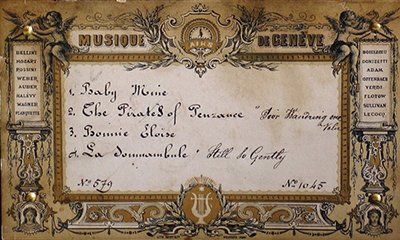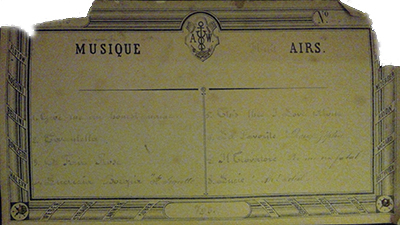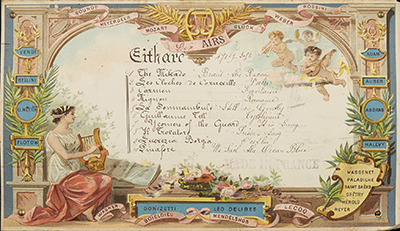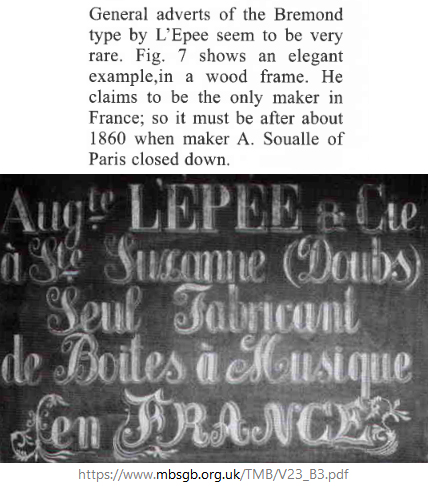|
L'Épée How to identify a music box of L’Épée according to Niko Wiegman
Second Chapter:Tunesheets With A Small Bulleid 3rd Suppl., Chart 3, p. 53 Bulleid, Technology, p. 74 and p. 75, table 5 (abridged)
Rahmendesign
Niko Wiegman, restorer of music boxes, discovered following anomaly (please click here)
Ein Teil der Schweizer Käufer, die bei ihren Landsleuten Spieldosen kauften, waren ihrerseits selber Spielwerkhersteller, die dringende Kundenwünsche aus dem Bestand der eigenen Produktion nicht bedienen konnten (Alfred Chappuis, 1955). So half einmal Geo Baker der Firma L'Épée aus, dann bezog Geo Baker seinerseits von PVF und von anderen nicht namentlich genannten Firmen, und auch die renommierte Firma Nicole musste einige 50.000-Werke bei PVF beziehen und musste, damit diese damit sie nicht auffallen, entsprechend adaptieren. Auguste L´Épée, *1798, † 1875 "Sainte-Suzanne, Doubs, France. In 1833, a native of Mont Béliard, named P. H. Paur, came to Sainte-Suzanne from Geneva where he had established a factory for making musical-box combs and decided to set up a musical-box industry using Swiss workers. His workshop was established in a blacksmith´s shop at the foot of the Mont-St-Michel." 1839, "after six years of costly and fruitless trials he [Paur] died almost a ruined man. For three months prior his death, his partner had been Auguste L´Épée, born at Villiers, Neuchatel, on 8 September 1798, and living in Beaucourt. Before coming to Paur, L´Épée had been director of the Japy clock company in Beaucourt." L´Épée "now bought Paur´s business and set up his own factory with little capital and great perseverance." "Research instituted by Mrs Mark Davis of Toledo reveals that he launched the fashion in France of musical movements in snuff-boxes, under dishes, in watches and so on, all of which had hitherto been a Swiss monopoly. In 1845 he had thirty workers and by 1850, by which time Auguste´s sons Henry (1829 – 1896) and Edouard were in the business, the factory was expanding." "In 1857, Auguste L´Épée invented the manivelle or small hand-cranked musical box for children, and this one line necessitated new production facilities." "In 1861, new workshops were built but, in the same year, Debain, the piano maker in Paris, instituted a law suit alleging infringement of copyright. The action, one of many over the mechanical interpretation of music, dragged on [...] until, in April 1863, the Court of Orléans, found for Debrain meaning, in effect, that the French manufacture of musical boxes playing other than national airs was no longer possible. The French government intervened to amend this invidious ruling and, on 4 July 1865, restored freedom. It had, though, cost L´Épée a considerable amount." New workshops again were built in 1869, but [1871], two years later Sainte-Suzanne, was the centre of a big battle in the war with the Germans and the village was occupied by Prussian troops. L´Épée´s factory became a field hospital until it was finally sacked by the soldiers who did great damage in particular to large numbers of finished musical boxes. Cruelty to Auguste L´Épée by the invaders hastened his death, which came on 7 February 1875 at the age of 77." The factory had, for some years, been run by the sons and the son-in-law and it was decided to keep the name as Auguste L´Épée. By 1878, 350 workers were employed. Large numbers of boxes were supplied to Thibouville-Lamy in Paris as well as to other outlets, but none appears to have been marked with the name. However, the crossed swords mark appears on several boxes attributed to L´Épée.! "In 1886, the company was co-patentee of an interchangeable-cylinder musical box with L.E.J. Thibouville-Lamy. [...]" "Henry L´Épée and his son Frédéric (1868 – 1931) made the first gramophone mechanics in France. Successor Henry L´Épée (1903 – 1864) lost his life in a car crash. Musical boxes were produced until 1914; today the business is the manufacture of precision instruments. Historical details from Roger Vreeland and Mrs Mark Davis."
Musikzettel mit einem Rahmendesign / Kleinformatige Spieldosen und Manivellen
Spielwerke mit dem Zeichen von L'Épée (1) Bitte hier klicken ( Spielwerke von L'Épée (3) (nach Saluz) 31-Zungen-Spielwerk; Likörgläser-Set mit Spielwerk ( Abbildungen von Manivelles (nach Bellamy) ( Paul Bellamy, Magical Manivelles, 2021
|












